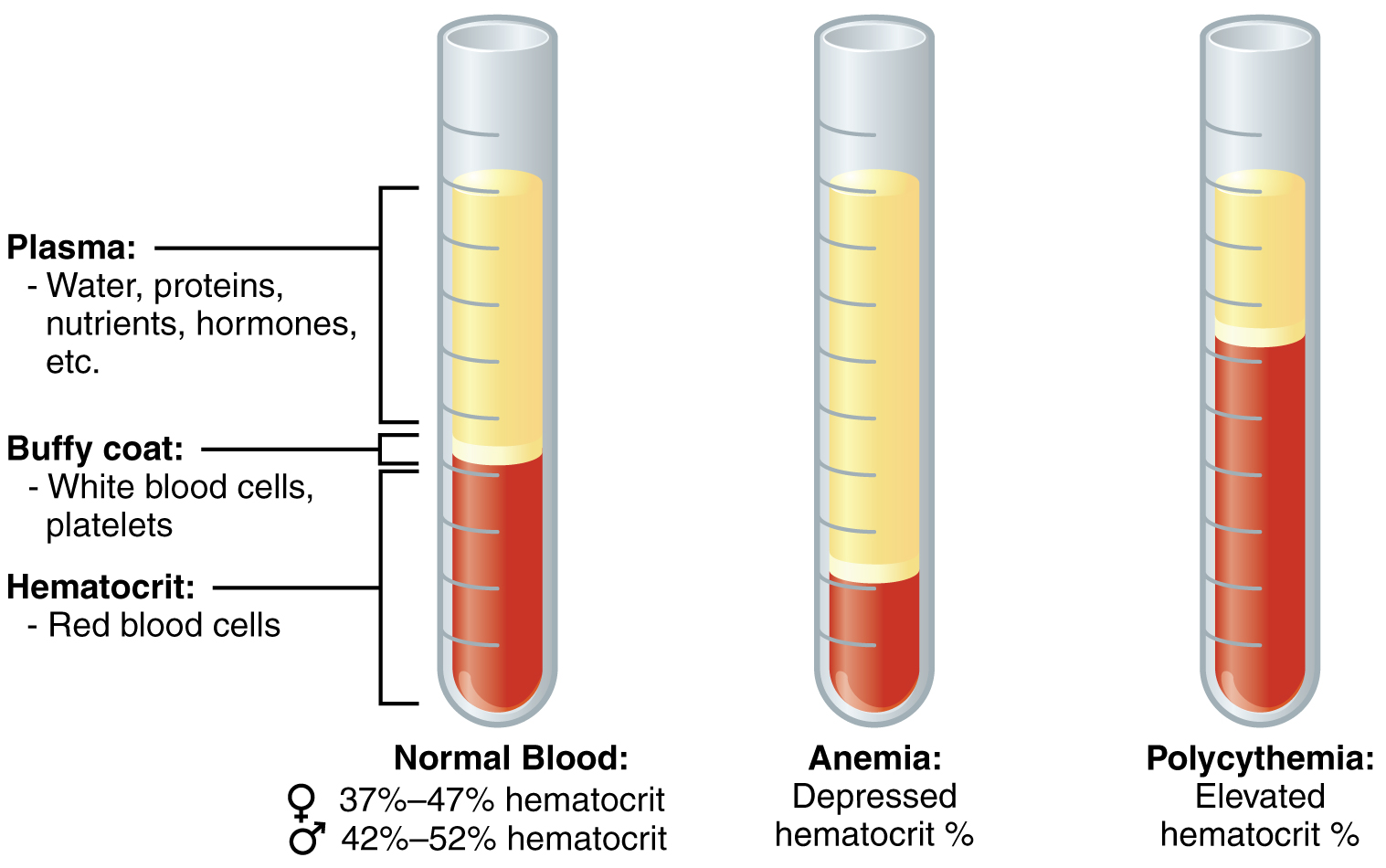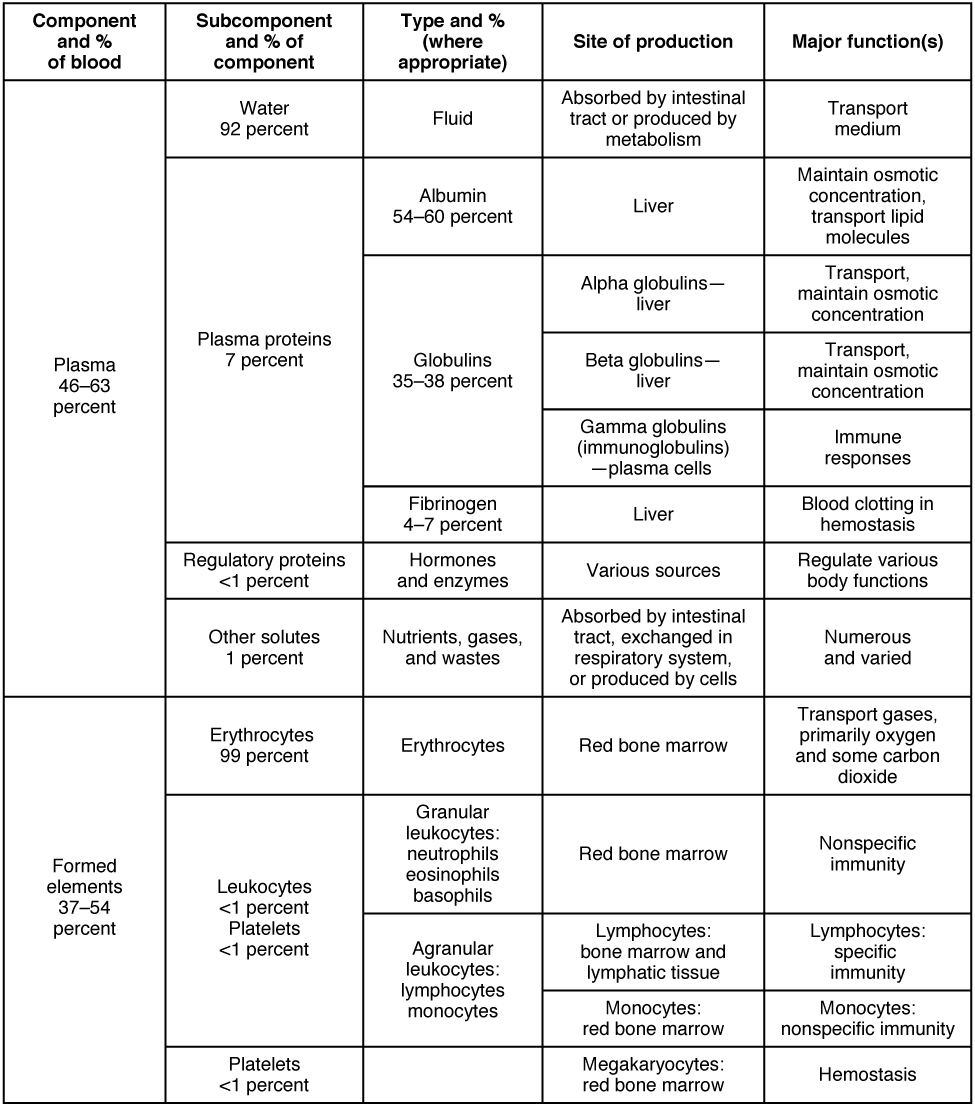Chapter 11. The Cardiovascular System: Blood
11.1 Functions of Blood
Learning Objectives
By the end of this section, you will be able to:
- Describe the primary functions of blood—specifically, its role in transportation, defense, and maintenance of homeostasis
- Describe the composition and physical characteristics of whole blood
- Define hematocrit and explain its physiological significance
- List the major components of plasma, their functions, and relative proportions
Recall that blood is a connective tissue. Like all connective tissues, it is made up of cellular elements and an extracellular matrix. The cellular elements—referred to as the formed elements—include red blood cells (RBCs), white blood cells (WBCs), and cell fragments called platelets. The extracellular matrix, called plasma, makes blood unique among connective tissues because it is fluid. This fluid, which is mostly water, suspends the formed elements and enables them to circulate throughout the body within the cardiovascular system.
Functions of Blood
The primary function of blood is to deliver oxygen and nutrients to, and remove wastes from, the body cells; but that is only the beginning of the story. The specific functions of blood also include defense, and maintenance of homeostasis, such as distributing heat where it is needed.
Transportation
Nutrients from the foods you eat are absorbed in the digestive tract. Most of these travel in the bloodstream directly to the liver, where they are processed and released back into the bloodstream for delivery to body cells. Oxygen from the air you breathe diffuses into the blood, which moves from the lungs to the heart, which then pumps it to the rest of the body. Moreover, endocrine glands scattered throughout the body release hormones into the bloodstream, which carries them to distant target cells. Blood also picks up cellular wastes and byproducts, and transports them to various organs for removal. For instance, blood moves carbon dioxide to the lungs for exhalation from the body, and various waste products are transported to the kidneys and liver for excretion from the body in the form of urine or bile.
Defense
Many types of WBCs protect the body from external threats, such as disease-causing bacteria that have entered the bloodstream in a wound. Other WBCs seek out and destroy internal threats, such as cells with mutated DNA that could multiply to become cancerous, or body cells infected with viruses.
When damage to the vessels results in bleeding, blood platelets and certain proteins dissolved in the plasma, interact to create clots which block the ruptured areas of the blood vessels involved. This protects the body from further blood loss.
Maintenance of Homeostasis
Recall that body temperature is regulated via a negative-feedback loop. If you were exercising on a warm day, your rising core body temperature would trigger several homeostatic mechanisms, including increased transport of blood from your core to your body periphery, which is typically cooler. As blood passes through the vessels of the skin, heat would be dissipated to the environment, and the blood returning to your body core would be cooler. In contrast, on a cold day, blood is diverted away from the skin to maintain a warmer body core. In extreme cases, this may result in frostbite.
Blood also helps to maintain the chemical balance of the body. Proteins and other compounds in blood act as buffers, which help to regulate the pH of body tissues. Blood also helps to regulate the water content of body cells because it has large proteins that exert osmotic pressure, which resist excessive fluid loss from the blood.
Composition of Blood
If you have had a blood test, it was likely drawn from a superficial vein in your arm, which was then sent to a lab for analysis. Some of the most common blood tests—for instance, those measuring lipid or glucose levels in plasma—determine which substances are present within blood and in what quantities. Other blood tests check for the composition of the blood itself, including the quantities and types of formed elements.
One such test examines hematocrit, which measures the percentage of RBCs (erythrocytes) in a blood sample. It is performed by spinning the blood sample in a specialized centrifuge, a process that causes the heavier elements suspended within the blood sample to separate from the lightweight, liquid plasma (Figure 11.1.1). Because the densest elements in blood are the erythrocytes, these settle at the bottom of the hematocrit tube. Located above the erythrocytes is a pale, thin layer composed of the remaining formed elements of blood. These are the WBCs (leukocytes) and the platelets (thrombocytes). This layer is referred to as the buffy coat, and it normally constitutes less than 1% of a blood sample. Above the buffy coat is the blood plasma, normally a pale, straw-colored fluid, which constitutes the remainder of the sample.
The volume of erythrocytes after centrifugation is also commonly referred to as packed cell volume. Typically, human blood contains about 45% erythrocytes, however, samples can vary significantly from about 36% to 50%. Normal hematocrit values for females range from 37% to 47%, with a mean value of 41%; for males, hematocrit ranges from 42% to 52%, with a mean of 47%. The percentage of other formed elements, the WBCs and platelets, is extremely small so it is not normally considered with the hematocrit. Therefore, the mean plasma percentage is the percent of blood that is not erythrocytes: for females, approximately 59% (or 100 minus 41), and for males, approximately 53% (or 100 minus 47).

Characteristics of Blood
When you think about blood, the first characteristic that probably comes to mind is its color. Blood that has just taken up oxygen in the lungs is bright red, and blood that has released oxygen in the tissues is a darker red. This is because hemoglobin is a pigment that changes color, depending upon the degree of oxygen saturation.
Blood is viscous, with a viscosity approximately five times greater than water. Viscosity is a measure of a fluid’s thickness or resistance to flow, and is influenced by the presence of the plasma proteins and formed elements within the blood. The viscosity of blood has a dramatic impact on blood pressure and flow. Consider the difference in flow between water and honey. The more viscous honey would demonstrate a greater resistance to flow than the less viscous water. The same principle applies to blood. Blood viscosity is inversely proportional to hydration; the more hydrated you are, the less viscous your blood becomes. In severely dehydrated individuals, blood can become excessively viscous sometimes resulting in infarction or other cardiovascular events.
The normal temperature of blood is slightly higher than normal body temperature—about 38°C (or 100.4°F), compared to 37°C (or 98.6°F) for an internal body temperature reading. Although the surface of a blood vessel is relatively smooth, blood experiences friction and resistance to its flow. This produces heat, accounting for the slightly higher temperature of blood.
The pH of blood averages about 7.4; however, it can range from 7.35 to 7.45 in a healthy person. Blood is therefore somewhat more basic (alkaline) on a chemical scale than pure water, which has a pH of 7.0. Blood contains numerous buffers that help to regulate pH.
Blood constitutes approximately 8% of adult body weight. Adult males typically average about 5 to 6 liters of blood, and females average 4 to 5 liters.
Blood Plasma
Plasma is 92% water. Dissolved or suspended within this water is a mixture of substances, most of which are proteins. There are hundreds of substances dissolved in the plasma, although many of them are found only in very small quantities.
External Website

Visit the National Board of Medical Examiners’ (NBME) site for a list of normal levels established for many of the substances found in a sample of blood. Serum, one of the specimen types included, refers to a sample of plasma after clotting factors have been removed.
Plasma Proteins
Approximately 7% of the plasma is made of proteins. These include several plasma proteins (proteins that are unique to the plasma), plus a much smaller number of regulatory proteins, including enzymes and hormones. The major components of plasma are summarized in Figure 11.1.2.
The three major groups of plasma proteins are as follows:
- Albumin is the most abundant of the plasma proteins. Manufactured by the liver, albumin molecules serve as binding proteins—transport vehicles for fatty acids and steroid hormones. Recall that lipids are hydrophobic; however, binding to albumin enables their transport in the watery plasma. Albumin is also the most significant contributor to the osmotic pressure of blood; that is, its presence holds water inside the blood vessels and draws water from the tissues, across blood vessel walls, and into the bloodstream. This in turn helps to maintain both blood volume and blood pressure. Albumin normally accounts for approximately 54% of the total plasma protein content, or 3.5 to 5.0 g/dL of blood.
- The second most common plasma proteins are the globulins. A heterogeneous group, there are three main subgroups known as alpha, beta, and gamma globulins. The alpha and beta globulins transport iron, lipids, and the fat-soluble vitamins A, D, E, and K to the cells; like albumin, they also contribute to osmotic pressure. The gamma globulins are proteins involved in immunity and are better known as an antibodies or immunoglobulins. Unlike alpha and beta globulins, which are produced in the liver, immunoglobulins are produced by specialized leukocytes known as plasma cells. Globulins make up approximately 38% of the total plasma protein volume, or 1.0 to 1.5 g/dL of blood.
- The least abundant plasma protein is fibrinogen. Like albumin and the alpha and beta globulins, fibrinogen is produced by the liver. It is essential for blood clotting, a process described later in this chapter. Fibrinogen accounts for about 7% of the total plasma protein volume, or 0.2 to 0.45 g/dL of blood.
Other Plasma Solutes
In addition to proteins, plasma contains a wide variety of other substances. These include various electrolytes, such as sodium, potassium, and calcium ions; dissolved gases, such as oxygen, carbon dioxide, and nitrogen; various organic nutrients, such as vitamins, lipids, glucose, and amino acids; and metabolic wastes. All of these non-protein solutes combined contribute approximately 1% to the total volume of plasma.

Career Connection – Phlebotomy and Medical Lab Technology:
Phlebotomists are professionals trained to draw blood (“phleb-” meaning “a blood vessel”; “-tomy” meaning “to cut”). When more than a few drops of blood are required, phlebotomists perform a venipuncture, typically of a surface vein in the arm. They perform a capillary stick on a finger, an earlobe, or the heel of an infant when only a small quantity of blood is required. An arterial stick is collected from an artery and used to analyze blood gases. After collection, the blood may be analyzed by medical laboratories or perhaps used for transfusions, donations, or research. While many allied health professionals practice phlebotomy, the American Society of Phlebotomy Technicians issues certificates to individuals passing a national examination, and some large labs and hospitals hire individuals expressly for their skill in phlebotomy.
Medical or clinical laboratories employ a variety of individuals in technical positions, including the following:
- Medical technologists, also known as clinical laboratory technologists, typically hold a bachelor’s degree and certification from an accredited training program. They perform a wide variety of tests on various body fluids, including blood. The information they provide is essential to the primary care providers in determining a diagnosis and in monitoring the course of a disease and response to treatment.
- Medical laboratory technicians typically have an associate’s degree but may perform duties similar to those of a medical technologists.
- Medical laboratory assistants spend the majority of their time processing samples and carrying out routine assignments within the lab. Clinical training is required, but a degree may not be essential to obtaining a position.
Section Review
Blood is a fluid connective tissue critical to the transportation of nutrients, gases, and wastes throughout the body; to defend the body against infection and other threats; and to the homeostatic regulation of pH, temperature, and other internal conditions. Blood is composed of formed elements—erythrocytes, leukocytes, and cell fragments called platelets—and a fluid extracellular matrix called plasma. More than 90% of plasma is water, with the remainder comprised of plasma proteins—mainly albumin, globulins, and fibrinogen—and other dissolved solutes such as glucose, lipids, electrolytes, and dissolved gases. Because of the formed elements, plasma proteins and other solutes, blood is more viscous than water. It is also slightly alkaline, and its temperature is slightly higher than normal body temperature.
Review Questions
Critical Thinking Questions
Glossary
- albumin
- most abundant plasma protein, accounting for most of the osmotic pressure of plasma
- antibodies
- antigen-specific proteins produced by specialized B lymphocytes that protect the body by binding to foreign objects such as bacteria and viruses (also immunoglobulins or gamma globulins)
- blood
- liquid connective tissue composed of formed elements—erythrocytes, leukocytes, and platelets—and a fluid extracellular matrix called plasma; component of the cardiovascular system
- buffy coat
- thin, pale layer of leukocytes and platelets that separates the erythrocytes from the plasma in a sample of centrifuged blood
- fibrinogen
- plasma protein produced in the liver and involved in blood clotting
- formed elements
- cellular components of blood; that is, erythrocytes, leukocytes, and platelets
- globulins
- heterogeneous group of plasma proteins that includes transport proteins, clotting factors, immune proteins, and others
- hematocrit
- volume percentage of erythrocytes in a sample of centrifuged blood (also packed cell volume)
- immunoglobulins
- antigen-specific proteins produced by specialized B lymphocytes that protect the body by binding to foreign objects such as bacteria and viruses (also antibodies or gamma globulins)
- plasma
- in blood, the liquid extracellular matrix composed mostly of water that circulates the formed elements and dissolved materials throughout the cardiovascular system
- platelets
- one of the formed elements of blood that consists of cell fragments broken off from megakaryocytes (also thrombocytes)
- red blood cells (RBCs)
- one of the formed elements of blood that transports oxygen (also erythrocytes)
- white blood cells (WBCs)
- one of the formed elements of blood that provides defense against disease agents and foreign materials (also leukocytes)
Glossary Flashcards
This work, Human Physiology, is adapted from Anatomy & Physiology by OpenStax, licensed under CC BY. This edition, with revised content and artwork, is licensed under CC BY-SA except where otherwise noted.
Images from Anatomy & Physiology by OpenStax are licensed under CC BY except where otherwise noted.
Access the original for free at OpenStax.
Image Descriptions
Figure 11.1.1. This educational diagram shows three test tubes containing separated blood components, illustrating normal blood composition compared to two medical conditions. Each tube displays three distinct layers: plasma (yellow) at the top containing water, proteins, nutrients, and hormones; buffy coat (thin white layer) in the middle containing white blood cells and platelets; and hematocrit (red) at the bottom containing red blood cells. The left tube labeled “Normal Blood” shows standard proportions with hematocrit levels of 37-47% for females and 42-52% for males. The middle tube labeled “Anemia” demonstrates a depressed hematocrit percentage with a noticeably smaller red blood cell layer and proportionally larger plasma layer. The right tube labeled “Polycythemia” displays an elevated hematocrit percentage with an increased red blood cell layer taking up more of the tube’s volume and a reduced plasma layer. The buffy coat remains relatively thin and consistent across all three examples. [Return to Figure 11.1.1]
Figure 11.1.2. This comprehensive table organizes information about blood composition into five columns: Component and % of blood, Subcomponent and % of component, Type and % (where appropriate), Site of production, and Major function(s). The table is divided into two main components. Plasma comprises 46-63 percent of blood and includes several subcomponents: Water at 92 percent serves as a transport medium and is absorbed by the intestinal tract or produced by metabolism. Plasma proteins at 7 percent include Albumin (54-60 percent, produced in the liver) which maintains osmotic concentration and transports lipid molecules; Globulins (35-38 percent) consisting of Alpha globulins and Beta globulins (both liver-produced for transport and osmotic concentration maintenance) and Gamma globulins or immunoglobulins (produced by plasma cells for immune responses); and Fibrinogen (4-7 percent, liver-produced) for blood clotting in hemostasis. Regulatory proteins at less than 1 percent include hormones and enzymes from various sources that regulate body functions. Other solutes at 1 percent consist of nutrients, gases, and wastes absorbed by the intestinal tract, exchanged in the respiratory system, or produced by cells, serving numerous and varied functions. Formed elements comprise 37-54 percent of blood and include: Erythrocytes at 99 percent, produced in red bone marrow, transport gases primarily oxygen and some carbon dioxide. Leukocytes at less than 1 percent and Platelets at less than 1 percent include Granular leukocytes (neutrophils, eosinophils, basophils) produced in red bone marrow for nonspecific immunity, and Agranular leukocytes (lymphocytes and monocytes) where lymphocytes are produced in bone marrow and lymphatic tissue for specific immunity, and monocytes are produced in red bone marrow for nonspecific immunity. Platelets at less than 1 percent are produced by megakaryocytes in red bone marrow and function in hemostasis. [Return to Figure 11.1.2]
Report an Error
Did you find an error, typo, broken link, or other problem in the text? Please follow this link to the error reporting form to submit an error report to the authors.
